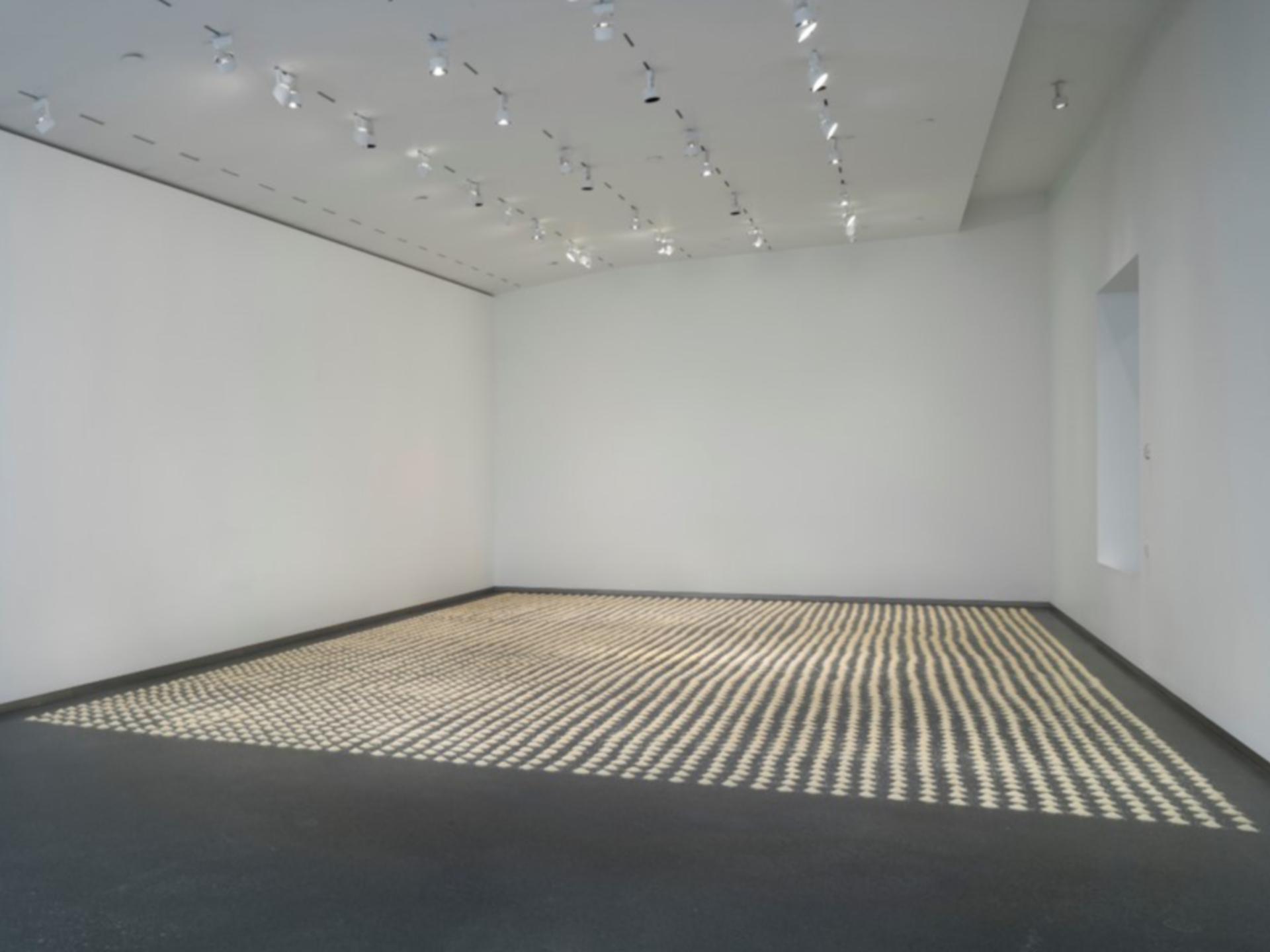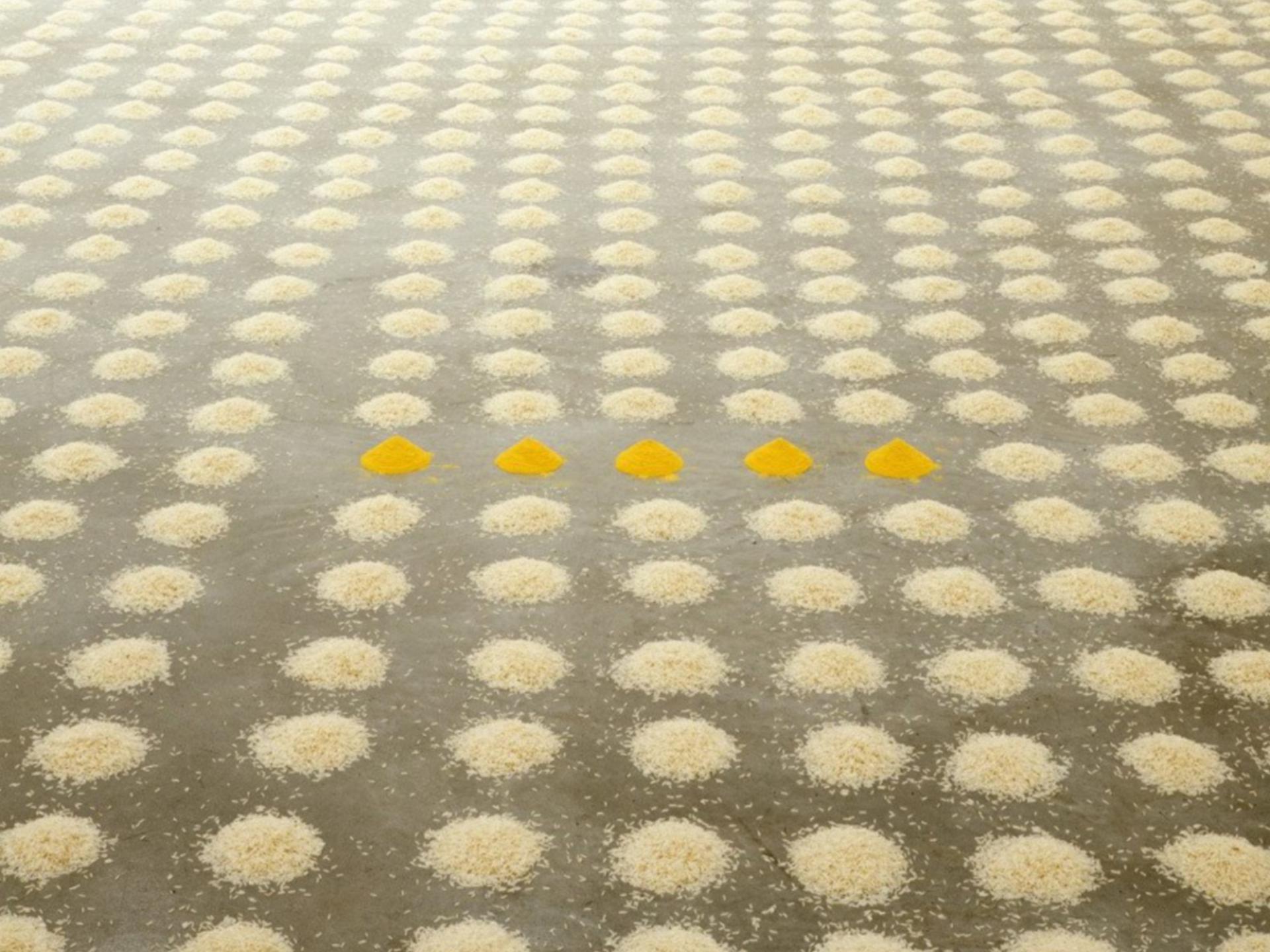4. Wolfgang Laib: Without Place – Without Time – Without Body, 2010
Artwork
According to Fenning (2025), Laib’s installation at The Nelson-Atkins Museum of Art, composed of hundreds of rice mounds with five yellow pollen mounds at centre, evokes a spiritual realm through its ritualistic use and arrangement of raw, natural materials. The circular configurations and carefully distributed living substances suggest cycles of life and regeneration, offering a ceremonial space where meaning is both immediate and transcendent. As Fenning (2025) further observes, the imperfect circular and linear formations, arranged directly on the gallery floor, embody the memory of the artist’s bodily movements. Each placement of rice and pollen, made by hand in a repeated gesture, functions as a quite act of searching, an attempt to locate an entrance into an alternate reality.
Living materials & Ceremonial Space
In Laib’s work, natural-living materials like pollen and rice symbolise Nature’s infinite life cycles and continuity. For me, this material logic extends to caraway seeds, which carry deep ritual significance in our Hungarian, rural familial culture. Beyond daily use, caraway seeds mark our life’s major ceremonies like weddings, christenings, and funerals. They act as quite carriers of memory, intimacy, and continuity. While they appear dry and dormant, they hold the promise of new life, activated by light and water. By arranging caraway seeds directly on the floor, alongside my woven, embroidered and braided objects, I aim to create a ceremonial space – an offering that connects my micro-world of self with the macro-world of the collective. It sustains an ongoing search and re-search for rootedness, familiarity, and relational ties through material inquiry into presence, closeness and emplacement.
Repeated gesture
Laib’s hand-distributed pollen and rice reflect an intimate, meditative ritual, transforming the gallery into a kind of secular shrine. The essence of the work lies not in the completed arrangement, but in the repeated gesture of collecting and placing; an intimate, ongoing search for an entrance into an alternate reality (Fenning, 2025). In my own practice, I engage in similar rhythmic acts like emplacing, weaving, braiding and embroidering. These ritualised, repetitive gestures bring forth ever evolving expanded objects and arrangements, linked by invisible threads that quietly express my continuous, try-again attempts to return home.
Living materials & Ceremonial Space
In Laib’s work, natural-living materials like pollen and rice symbolise Nature’s infinite life cycles and continuity. For me, this material logic extends to caraway seeds, which carry deep ritual significance in our Hungarian, rural familial culture. Beyond daily use, caraway seeds mark our life’s major ceremonies like weddings, christenings, and funerals. They act as quite carriers of memory, intimacy, and continuity. While they appear dry and dormant, they hold the promise of new life, activated by light and water. By arranging caraway seeds directly on the floor, alongside my woven, embroidered and braided objects, I aim to create a ceremonial space – an offering that connects my micro-world of self with the macro-world of the collective. It sustains an ongoing search and re-search for rootedness, familiarity, and relational ties through material inquiry into presence, closeness and emplacement.
Repeated gesture
Laib’s hand-distributed pollen and rice reflect an intimate, meditative ritual, transforming the gallery into a kind of secular shrine. The essence of the work lies not in the completed arrangement, but in the repeated gesture of collecting and placing; an intimate, ongoing search for an entrance into an alternate reality (Fenning, 2025). In my own practice, I engage in similar rhythmic acts like emplacing, weaving, braiding and embroidering. These ritualised, repetitive gestures bring forth ever evolving expanded objects and arrangements, linked by invisible threads that quietly express my continuous, try-again attempts to return home.
Bibliography
Fanning, L. (2010) Wolfgang Laib: Without Place – Without Time – Without Body. Available at: https://www.leesafanning.com/exhibitions#/wolfganglaib (Accessed: 20 April 2025).
Fanning, L. (2010) Wolfgang Laib: Without Place – Without Time – Without Body. Available at: https://www.leesafanning.com/exhibitions#/wolfganglaib (Accessed: 20 April 2025).

